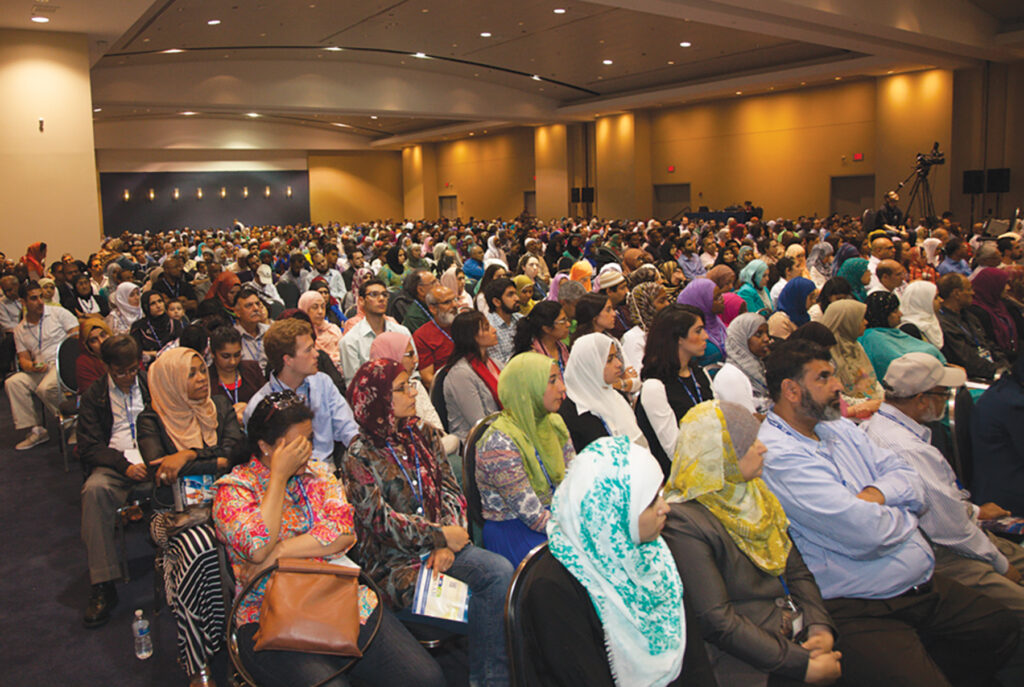By Rasheed Rabbi
Sept/Oct 2023

As the summer sun gently retreats beyond the horizon, an unmistakable air of anticipation permeates the atmosphere, heralding the annual ISNA convention. This mega event exerts a magnetic force that draws throngs of Muslim Americans, united in their fervent pursuit of knowledge, connection, and inspiration. The convention halls come alive, transformed into bustling hives of lectures and activities, echoing with the eager footsteps of attendees traversing the long corridors of Chicago’s Donald Stephen Convention Center. Every inch of the premises seems infused with an inherent rush, guiding each person from one captivating session to the next, leaving them wanting for more. With each passing year, the fervor intensifies, and the race to attend sessions surges as the program ambitiously expands, featuring an array of topics as diverse as the stars in the night sky.
To outsiders, it may seem like a familiar picture repeating itself annually — thousands of individuals hurrying from hall to hall, clutching their program catalogs like cherished treasures, their eyes alight with excitement. The inexperienced may question the utility of including so many sessions, spanning from deeply personal narratives to issues of local importance, and even touching upon global challenges faced by Muslims.
A Grand Vision
But beneath this seemingly repetitive surface lies a tapestry of intricate dynamics, interwoven with layers of purpose and meaning. The whirlwind of activities transforms them into participants of a movement that crosses the confines of national or ethnic borders. Within the seemingly modest organization called ISNA, a grand and audacious vision has spread its roots, blooming flickers of hope even in the most skeptical of hearts.
As the vision and hope weave together people from diverse backgrounds, cultures, and ages, a vibrant mosaic of experiences and perspectives continues to emerge. Each thread flaunts its distinct character, seamlessly woven into the fabric of a united community, converging hyphenated identities and bridging the gaps of yesterday, today, and tomorrow. With every passing year, the convention has ensued a unique space of connection, discovery, exploration, and growth. Within this sacred space, fundamental human questions find answers — “Who am I?” “Where do I belong?” and “How can I be a bridge to a brighter future?”
True observers get to witness the interplay of diverse voices and visions coming together in a symphony of harmony, each note adding to the larger narrative of the Muslim American community’s journey and their generational transitions. Serving as a vantage point, this convention allows Muslims to observe and understand the evolving dynamics of individual identity and their respective communities in North America. It unfolds a comprehensive view of generational shifts, reshaping Muslim Americans’ identity, priorities, and aspirations.
Cast back to 1963, ISNA members acknowledged the Eid festivals by exchanging heartfelt greetings through the simple yet meaningful Eid cards. In those early days, the Muslim American communities were significantly few and still in their infancy, forging their paths in a society largely unfamiliar with Islam. In that context, the exchange of Eid cards served as a beacon, fostering connections, celebrating religious holidays, and nurturing a sense of belonging despite their small numbers. However, it marks a time of only laying a solid foundation for future growth by building strong brotherhood.
Fast forward to the year 2022, where the ISNA convention celebrated approved Eid holidays in multiple states across the nation. It hosted a full session showcasing kids’ captivating movies based on the life of the famous Persian spiritual leader, Jalaluddin Rumi. This powerful display embodies how American Muslims are coming of age and expanding their spiritual heritage, seeking innovative ways to pass it on to the younger generation in a manner that engages and resonates with their youthful hearts. These are just a couple of many changes of convention themes and topics, which bear testimony to the generational evolution from defending to defining themselves.
From its early years centered on forging a sense of community and religious identity among immigrant Muslim populations, the ISNA convention has evolved into a powerhouse addressing pressing issues like voicing against injustice, eliminating biases, and securing Muslims’ equal rights in America. Again, Muslim security is enforced not by protecting them with high walls, but by giving them all possible resources, and its convention is the plugging point of all appropriate networks to instill confidence and bargain for what they need. This transformation signifies a significant shift from mere survival to a proactive approach of shaping their narrative.
In the past, many lecture sessions emphasized the importance of establishing mosques and Islamic centers, creating sacred spaces for newcomers to connect with fellow Muslims, preserving their cultural and religious heritage in a foreign land. Now, the convention includes sessions to educate Muslim communities on how to combat animosity in neighborhoods and challenge unjust opposition from county offices.
Themes Over the Years
Many such transitions become apparent as the tides of history unfold. During the mid-sixties and seventies, the ISNA convention hosted sessions to highlight the importance of adhering to Islamic practices amidst dominant secularizing Judeo-Christian ideals in America. Whereas, in the following decade, mid-seventies to eighties, it stressed on refuting implicit blame on Islam and restoring American Muslims’ image. In the post-2001, after 9/11, the convention sessions emphasized on raising American non-Muslims’ awareness of Islam through interfaith collaboration and political participation, and lastly after 2016, an increasing number of sessions are allocated in raising civil rights and political awareness of domestic Muslims.
These changes in the convention’s topics and themes transcend mere events; they personify the profound generational shift that has taken place within the Muslim American community. A shift reverberating through language and cultural expression, radiating the demographic transformation of the Muslim American identity. While the early years saw predominantly English language sessions, the exponential growth and diversification of Muslim communities in America have given rise to sessions conducted in multiple languages, namely Arabic, Turkish, Urdu or Hindi, honoring the needs of the younger, American-born generation.
Additionally, the inclusion of various art forms, including spoken word, poetry, and music, at the convention showcases how the contemporary Muslims seek to express their faith and cultural identity in creative and innovative ways. Such a rich convention outline plays as a powerful tool for engaging and connecting with young attendees, allowing them to see their values and experiences reflected in the convention’s programming.
Under the presidency of Dr. Ingrid Matson, ISNA consciously ensured to have women speakers for all main and parallel sessions. These changes and the expansion of topics, including discussions on social justice, human rights, environmental sustainability, and civic engagement, resonate with the heightened awareness of broader societal issues.
It’s important that Muslim American communities undergo many such transitions not as a linear experience; rather it represents a profound blend of past realities and present possibilities. ISNA itself has changed its strategy to ensure the maximum coverage for mirroring this generational shift comprehensively. Previously, ISNA spent their time working for religious committees and guilds, but now they let professional experts – writers, artists, therapists, spiritual guides — be the producers while they consume what they need to enrich themselves spiritually and holistically. This strategic change encourages Muslims to view their religion anew and realize that Islam is no longer something people inherit, but something for which they strive.
Next 60 Years
The claim made by ISNA executive director, Basharat Saleem, that the convention “has ably served the community for 60 years, and we are ready to embark on our journey for the next 60” is not an exaggeration at all. The convention embodies the changing needs and interests of its attendees, reflecting the awe-inspiring growth, diversity, and dynamism of the community. Beyond merely connecting various generations, it artfully bridges the gap between the rich heritage of the past and the vibrant aspirations of the future.
As the convention continues to be redesigned, let us witness the Muslim Americans’ evolution and learn our distinct individual influence and contribution. Let us find our rightful place in the broader community and understand how the Muslim identity — individually and collectively — has been reshaped by the social factors to which we have been subject from time to time in America. Such an understanding will not only enrich our appreciation for the Muslim growth in America but also enhance our ability to meet challenges of the time ahead.
Rasheed Rabbi is an IT professional who earned an MA in religious studies from Hartford Seminary and is pursuing a Doctor of Ministry from Boston University. He is also the founder of e-Dawah (www.edawah.net) and secretary of the Association of Muslim Scientists, Engineers & Technology Professionals. He serves as a khateeb and Friday prayer leader at the ADAMS Center and a certified Muslim chaplain at iNova Fairfax, iNova Loudoun and Virginia’s Alexandria and Loudoun Adult Detention Centers.
Tell us what you thought by joining our Facebook community. You can also send comments and story pitches to horizons@isna.net. Islamic Horizons does not publish unsolicited material.
